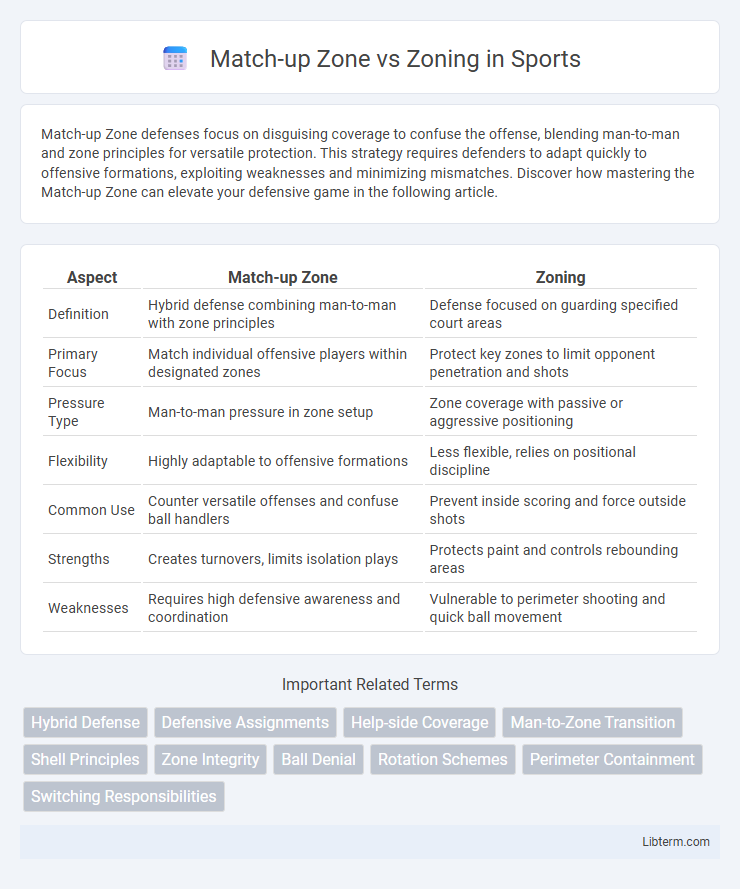Match-up Zone defenses focus on disguising coverage to confuse the offense, blending man-to-man and zone principles for versatile protection. This strategy requires defenders to adapt quickly to offensive formations, exploiting weaknesses and minimizing mismatches. Discover how mastering the Match-up Zone can elevate your defensive game in the following article.
Table of Comparison
| Aspect | Match-up Zone | Zoning |
|---|---|---|
| Definition | Hybrid defense combining man-to-man with zone principles | Defense focused on guarding specified court areas |
| Primary Focus | Match individual offensive players within designated zones | Protect key zones to limit opponent penetration and shots |
| Pressure Type | Man-to-man pressure in zone setup | Zone coverage with passive or aggressive positioning |
| Flexibility | Highly adaptable to offensive formations | Less flexible, relies on positional discipline |
| Common Use | Counter versatile offenses and confuse ball handlers | Prevent inside scoring and force outside shots |
| Strengths | Creates turnovers, limits isolation plays | Protects paint and controls rebounding areas |
| Weaknesses | Requires high defensive awareness and coordination | Vulnerable to perimeter shooting and quick ball movement |
Introduction to Match-up Zone and Zoning
Match-up Zone defense combines elements of man-to-man and zone, where defenders are assigned to guard players within specific areas but switch to man-to-man coverage when an offensive player enters their zone. Zoning defense, in contrast, assigns defenders to protect designated court areas, focusing on team positioning rather than individual matchups to contain ball movement and prevent easy scoring opportunities. Understanding the hybrid nature of Match-up Zone helps teams disrupt offensive patterns by blending spatial awareness with personalized defensive pressure.
Defining Match-up Zone Defense
Match-up zone defense combines elements of man-to-man and zone defenses, where defenders are responsible for guarding specific opponents within designated areas on the court. This hybrid strategy emphasizes adaptability by matching up with offensive players based on their positioning rather than strict zones, increasing pressure on ball handlers and limiting easy passing lanes. Key components include communication, quick switching, and spatial awareness to effectively counter offensive movements and exploit weaknesses.
Key Principles of Traditional Zone Defense
Traditional zone defense relies on key principles such as area responsibility, where defenders guard specific court zones rather than individual players, enhancing spatial control and force opponents into low-percentage shots. Emphasis on communication and rotations ensures defensive balance when offensive players penetrate or move rapidly, maintaining coverage integrity. Match-up zone integrates man-to-man elements but traditional zone prioritizes containment and help defense within fixed regions to limit driving lanes and passing options.
Strategic Differences Between Match-up Zone and Zoning
Match-up zone defense combines man-to-man principles with zone concepts, requiring players to match up with opponents within a defined area, enhancing flexibility and responsiveness to offensive movements. Zoning relies on guarding specific court areas, emphasizing spatial control and forcing offenses to take lower percentage shots from the perimeter. The strategic difference lies in match-up zone's adaptability to individual threats, contrasting with zoning's focus on collective containment and gap coverage.
Advantages of Match-up Zone Defense
Match-up zone defense combines the strengths of man-to-man and zone defenses, creating versatile coverage that adapts to offensive movements and reduces mismatches. This defensive strategy enhances ball pressure and denies passing lanes more effectively than traditional zoning, leading to increased turnovers and disrupted offensive rhythm. Teams using match-up zones benefit from improved communication and switching versatility, optimizing defensive assignments against high-scoring opponents.
Weaknesses in Zone and Match-up Zone Strategies
Zone defenses often struggle against quick passes and agile players who exploit soft spots in coverage, leading to vulnerabilities in both the short and intermediate passing game. Match-up zone schemes can expose mismatches when defenders are forced to guard more athletic opponents in space, reducing effectiveness against versatile offenses. Both strategies require precise communication and awareness, but breakdowns in assignment or delayed reactions commonly result in blown coverage and big plays.
Effective Situations for Using Match-up Zone
Match-up zone defenses excel in situations where opposing teams have versatile scorers who thrive in isolation or pick-and-roll scenarios, allowing defenders to adapt quickly to multiple offensive threats without rigid man-to-man assignments. This defensive scheme is effective against offenses that use frequent ball movement and off-ball screens, as it enables defenders to switch seamlessly and provide help defense while maintaining accountability. Employing a match-up zone disrupts rhythm by confusing shooters and limiting open looks, especially when facing teams that rely on perimeter shooting and dynamic playmaking.
Common Misconceptions About Zoning Defenses
Many mistakenly believe that zoning defenses in basketball are less effective than man-to-man or match-up zone defenses, overlooking their strategic value in limiting penetration and forcing low-percentage perimeter shots. Another common misconception is that zoning defenses allow more offensive rebounds; however, modern zone tactics incorporate effective positioning to contest rebounds aggressively. Furthermore, some assume that players in a zoning scheme lack defensive responsibilities, ignoring that successful zones require precise communication and active rotation to cover gaps.
Case Studies: Successful Teams Utilizing Match-up Zone
Teams like the University of Virginia and Syracuse University have effectively utilized the match-up zone defense to disrupt opponents' offensive rhythms and enhance defensive versatility. Case studies reveal how these teams leverage the hybrid defensive scheme to combine the principles of man-to-man and zone defense, forcing turnovers and improving defensive efficiency. Statistical analyses show a significant decrease in opposing teams' shooting percentages and increased forced turnovers when match-up zones are employed successfully.
Choosing the Right Defense for Your Team
Match-up zone defense combines the principles of man-to-man and zone defenses, assigning players to guard specific areas while following offensive players within those zones. Zoning emphasizes protecting space and forcing opponents to take low-percentage shots by guarding designated court areas rather than individual players. Choosing the right defense depends on your team's athleticism, communication skills, and opponent's offensive strengths, with match-up zones benefiting versatile defenders and zonings suiting teams strong in positioning and anticipation.
Match-up Zone Infographic

 libterm.com
libterm.com